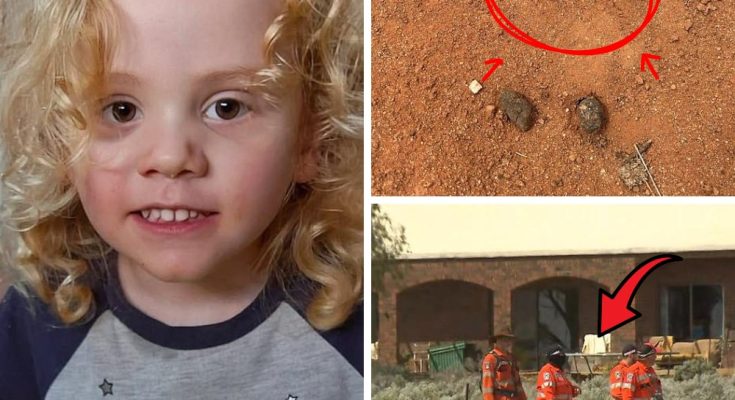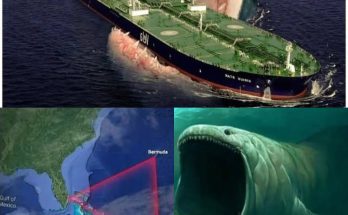In the vast, unforgiving expanse of South Australia’s mid-north outback, where the horizon blurs into a haze of red dust and stunted bluebush, a family’s worst nightmare unfolded on a deceptively ordinary Saturday afternoon. Four-year-old August Lamont—affectionately known as Gus to those who loved him—vanished without a trace from the front yard of his grandparents’ remote sheep station, leaving behind only the echo of his laughter and a single, haunting footprint in the parched earth. It was September 27, 2025, and what began as a playful dig in a mound of dirt with a child’s shovel spiraled into one of the most exhaustive and emotionally wrenching searches in recent Australian history. Now, six days later on October 2, with temperatures plunging to bone-chilling lows under starlit skies, authorities have delivered a tragic update: the operation has shifted from desperate rescue to somber recovery. As the clock ticks past 100 hours without food, water, or shelter for the blonde-curled preschooler, the outback’s silence grows louder, a cruel reminder of nature’s indifference to human fragility.
The Lamont family’s homestead sits like a solitary sentinel on a sprawling 6,000-hectare property, some 40 kilometers south of the dusty speck that is Yunta—a town of just 100 souls, equidistant from Adelaide’s urban hum (350 kilometers south) and the industrial sprawl of Port Augusta (200 kilometers west). This is sheep country, where generations have wrestled sustenance from the land’s reluctant grip: hardy merinos grazing on saltbush, windmills creaking against the relentless Flinders Ranges gales. Gus, a quiet yet adventurous spirit with a mop of long, golden curls that caught the late-afternoon sun like a halo, was here visiting his grandparents, a routine escape from the slightly less remote family home. At 5 p.m., as the day’s heat began to ebb, he was spotted joyfully scooping sand outside the weathered homestead, his tiny boots kicking up puffs of ochre soil. His grandmother, glancing out from the kitchen window, called his name moments later. No answer. No rustle of movement. Just the wind whispering through the mallee scrub.
Panic set in swiftly. The family fanned out across the immediate grounds, calling into the gathering dusk, their voices swallowed by the isolation. For three agonizing hours, they combed the yard, the nearby sheds, even the shallow creek beds that crisscross the property like faint scars. By 8:30 p.m., with darkness cloaking the landscape, they dialed South Australia Police. Officers arrived by 9:30, deploying a helicopter equipped with infrared imaging to sweep the terrain from above. The thermal scans pierced the night, hunting for any anomalous heat signature—a huddled form, perhaps, curled against the cold—but yielded nothing. Gus, described in the initial alert as a Caucasian boy in a grey sun hat, cobalt blue long-sleeved T-shirt emblazoned with a cheerful yellow Minions character, light grey pants, and sturdy boots, had evaporated into the ether.
Dawn broke on September 28 with a renewed fury. Ground teams mobilized at first light: trail bikes zipping across the red plains, all-terrain vehicles (ATVs) churning through spinifex clumps, and a drone humming overhead, its camera eye scanning a 2.5-kilometer radius from the homestead. Pager alerts rippled out to State Emergency Service (SES) volunteers across the mid-north, pulling in locals from as far as Adelaide. Sniffer dogs strained at leashes, noses to the ground, while mounted police units picked their way through thorny acacia thickets. Water operations specialists probed the property’s dams and stock tanks—vital but treacherous oases in this arid belt, where a toddler could slip unseen into depths swollen by recent rains. By afternoon, a police press release painted a vivid portrait of the missing child, urging the public to share sightings or tips via Crime Stoppers. “Gus is a little boy who loves adventures,” it read, “but we need him home safe.” Yet, the outback offered no mercy; the search covered miles of unforgiving scrub, but the boy remained elusive.
Monday, September 29, brought a grim resolve. Superintendent Mark Syrus, overseeing the Yorke and Mid-North region, addressed the media from a dusty command post improvised near the homestead. “We believe Gus has wandered off,” he stated flatly, his face etched with the weight of experience. “He’s a curious kid, and in this environment, distances can deceive.” The theory guided the day’s efforts: mounted teams expanded into the property’s fringes, where wombat burrows and salt pans dotted the landscape, while divers in wetsuits scoured deeper water bodies. Community volunteers swelled the ranks—neighbors from Yunta, farmers delaying musters, even passing truckies detouring to lend hands. Aerial sweeps continued, the chopper’s rotors a constant thrum against the sky. But as the sun dipped, casting long shadows over the bluebush, exhaustion crept in. Gus had now been out overnight twice, exposed to diurnal swings from 30°C scorchers to sub-zero chills. Dehydration, hypothermia, exposure—the specters loomed larger with each passing hour.
Hope flickered briefly on Tuesday, September 30, like a match struck in the wind. Amid the grid-like sweeps—teams methodically gridding quadrants with fluorescent markers—a breakthrough: a single child’s footprint, etched into the hardpan about 500 meters north of the homestead. Forensic experts confirmed the tread pattern matched Gus’s boots, a tantalizing breadcrumb in the vastness. “This could be our path,” Syrus told reporters, his voice laced with cautious optimism. A local tracker, a grizzled elder with decades etched into his skin and an intimate knowledge of the station’s hidden folds—having once worked the very land—joined the fray. His eyes, trained to read the subtlest disturbances in the soil, traced potential trails: a scuff here, a bent stem there. The family, through spokesperson Bill Harbison, released a statement that afternoon, their words a raw wound laid bare. “Gus’s absence is felt in every corner of our home,” Harbison read, voice trembling. “We are in shock, we are devastated, but we hold onto the belief that he is still out there, waiting for us. Please, keep looking.” For the first time, police shared an image of a Minions T-shirt akin to Gus’s, a heartbreaking touchstone for a nation now glued to the unfolding drama.
Wednesday, October 1, marked the pivot toward darkness. As the search clocked 80 hours without sustenance for the boy, whispers of a shift from search to recovery began circulating among the ranks. Major Crime Investigation Branch detectives arrived—not implying foul play, but as protocol demands in prolonged child disappearances. Forty police cadets, fresh-faced and fueled by determination, bolstered the lines, combing gullies where a small form might huddle under a saltbush canopy. Syrus faced the cameras again, his optimism fraying at the edges. “Gus is quiet but adventurous,” he said. “He might have crawled into a hollow log or under a bush to hide from the elements. We’re not giving up.” Yet, privately, discussions with the family turned somber: survival odds plummeted after three nights. Animal attacks weren’t ruled out—dingoes prowling the fringes, or wedge-tailed eagles scouting from thermals—but the prevailing narrative held: a toddler’s innocent wander into peril. The footprint, once a beacon, now raised questions; no trail emanated from it, no second print to corroborate.
By Thursday, October 2—the sixth full day—the weight proved unbearable. Assistant Commissioner Ian Parrott delivered the gut-punch update from the state operations center in Adelaide, his tone measured but heavy with finality. “We’ve informed the family that, regrettably, we’re moving into a recovery phase,” he announced, the words landing like stones in still water. The operation, one of South Australia’s most intensive ever, had mobilized no fewer than 50 personnel daily: foot teams logging 25 kilometers of trudging through thorns and heat, ATVs and motorbikes carving paths through impenetrable scrub, divers plumbing icy waters. Drones buzzed relentlessly, infrared tech scanned for body heat until batteries waned. Some 50 Australian Defence Force members augmented the effort, their training in hostile terrains lending precision to the chaos. That skilled tracker pored over the footprint site anew, but doubt crept in: Could it be days old? A week? No corroborating marks, no discarded hat or shirt scrap. Coverage spanned roughly 470 square kilometers of the 6,000-hectare beast, yet the outback’s scale mocked human endeavor—a labyrinth of dry creek beds, abandoned mine shafts from the 1800s gold rush, and unmarked wells sunk deep for thirsty stock.
The environmental gauntlet is as much villain as venue. Yunta’s outback is a study in extremes: daytime temps hovering near 25°C give way to nights dipping below freezing, the coldest in the state this week. The red dirt bakes footprints into brittle relief by noon, erasing them by dusk under wind-whipped sands. Bluebush and saltbush offer scant cover, their thorny embrace shredding clothes and skin alike. Hidden hazards lurk: century-old prospecting shafts, camouflaged by overgrowth, plunge 10 meters or more—silent traps for the unwary. Unmarked bores, drilled for livestock, yawn like forgotten graves. “It’s the sort of place where a kid can vanish in a blink,” lamented Royce Player, a former neighbor and goat herder who joined the search, his weathered hands gripping a radio as he recounted scouring the same square thrice over. “Gus is tiny—barely knee-high on me. He could be curled up anywhere, waiting.” Michael Atkinson, a survivalist and ex-ADF pilot, echoed the plea for aerial vigilance, insisting a farm-raised boy like Gus—toughened by rural rhythms—might yet endure on dew-kissed leaves or instinct alone.
The Lamonts, shrouded in grief’s fog, have become symbols of stoic endurance. Harbison, their voice, updates the press with a dignity that belies the torment: sleepless vigils by the homestead gate, meals untouched, prayers murmured into the void. Gus’s parents, siblings if any unspoken, hover in the periphery, their world contracted to this patch of earth. Community response has been a torrent of solidarity—Yunta’s pub transformed into a volunteer hub, sandwiches and thermoses flowing from Adelaide sympathizers. Social media pulses with #FindGusNow, timelines flooded by shared maps, prayer chains, and composite sketches. “He’s out there, our little adventurer,” one aunt posted, a photo of Gus grinning gap-toothed on a toy tractor. Experts from child advocacy groups weigh in, praising the response’s scale while cautioning against false hope. “Outback losses like this scar deep,” noted one psychologist. “But they forge unbreakable bonds too.”
As October’s chill deepens, the recovery phase stretches ahead: forensics teams sifting finer, cadaver dogs on standby, inquiries probing every angle from accidental falls to the improbable abduction. Parrott vows persistence: “We’ll chase every lead until we bring Gus home—for answers, if not embrace.” For the Lamonts, the footprint endures not as clue, but talisman—a mark of whimsy turned tragedy, boots that once tromped joyfully now ghosts in the dust. In this land of ancient custodians and fleeting rains, Gus’s story transcends one boy: it’s a requiem for innocence adrift, a call to cherish the fragile line between play and peril. The outback, vast and veiled, holds its secrets close. But somewhere, in a thicket’s hush or a shaft’s shadow, a curl of blonde hair waits. And in Yunta’s quiet heart, hope flickers on—defiant, diminishing, but unextinguished.



